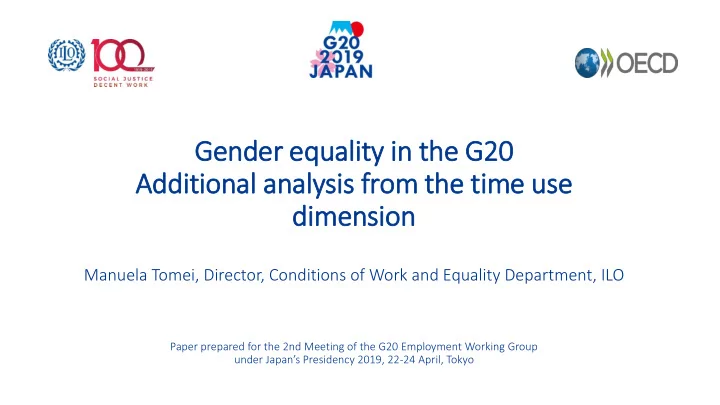

Gender equality in in the G20 Additional analysis fr from the tim ime use dim imension Manuela Tomei, Director, Conditions of Work and Equality Department, ILO Paper prepared for the 2nd Meeting of the G20 Employment Working Group under Japan’s Presidency 2019, 22 -24 April, Tokyo
Women are more likely to work short hours for pay or profit (less than 35 hours per week) Per ersons wor orking les ess than 35 35 ho hours s per per week eek, by y se sex, 2012 2012 an and latest t yea ear Source: ILOSTAT, 2019.
..while men are more likely to work very long-hours for pay or profit (more than 48 hours per week) Very ery long ho hours s of of work ork (m (more than 48 48 ho hours a a wee eek), latest year ear. Source: ILOSTAT, 2019.
Unpaid care work is still disproportionately performed by women Tim ime spe spent da daily ily in n un unpaid care wor ork, pa paid id work ork an and to total l wor ork, , by y se sex, x, latest year ear Source: ILO 2018. Care work and care jobs for the future of decent work (Geneva).
Where women devote less time to unpaid care work, their employment levels are higher Women’s emplo loyment-to to-population ratio and the gender gap in the share of time spent in unpaid care work Equal sharing of of time spent in tim in unpaid care work Gen ender eq equality in in la labour market ou outcomes Source: Employment-to-population ratio: ILO calculation based on ILO modelled estimates, November 2018. Gender gap in unpaid care work: ILO 2018. Care work and care jobs for the future of decent work (Geneva)
The ‘motherhood wage penalty’ Motherhood and fatherhood wage gaps, latest year Source: ILO 2018. Global Wage Report 2018/19: What lies behind gender pay gaps (Geneva).
The ‘motherhood leadership penalty’ Sh Share of of managers with th an and with thout ch chil ildren un under 6 6 year ears of of ag age, e, by y se sex, , latest yea ear Source: ILO, 2019. A quantum leap for gender equality. For a better future of work for all (Geneva).
General policy directions Increasing investments in childcare and long-term care services Em Employment-to to-popula lation rati tio of of wom omen with th you oung • Availability, affordability and quality of public care services is ch chil ildren (0 (0 – 5 year ears) an and gr gross oss enr enrolm lment rate in n ear early ly- crucial for reducing women’s unpaid care work and advance chil ch ildhood ed education an and car are gender equality • Closing the coverage gap in early childhood education and care is pivotal to remove the ‘motherhood penalties’ in labour markets • Improving coverage of out-of-school hours care services is also crucial for full-time employment, including during school holidays • Closing the coverage gap in long-term care is equally key to keeping women workers in the labour market Source: ILO calculations based on ILO, 2019. A quantum leap for gender equality. For a better future of work for all (Geneva)
General policy directions (continued) • Well-designed leave policies and entitlements • Well-paid paternity leave and father-specific parental leave • Duration of maternity leave • Challenging stereotypes and norms around caregiving and housework • Awareness campaigns • Valuing and recognising time spent in unpaid care work • Closing the data gaps on gender inequalities in work-life balance • time-use surveys • data collection on fathers’ leave-taking • public opinion surveys
Thank you
Recommend
More recommend